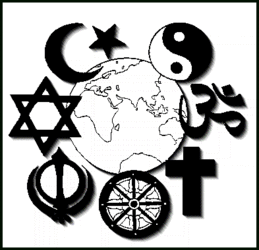In this project looking at the intersection of food and religion in Burlington, we set out to understand the social and personal difficulties that followers of various faiths might face in maintaining their chosen food ways. We were able to explore some of the realities of foodways through our research, especially focusing on the practices of UVM students and Burlington-area residents.
food
Burlington Buddhist Practice
The conflicting sutra about eating meat and the variety of reasons for Buddhist vegetarian practice sparked my interest. I wanted inquire more about Burlington Buddhist dietary practices and beliefs, a how they are impacted by the local food-ways. I faced few obstacles finding Buddhists in the Burlington area. I was able to interview a Buddhist Priest named Dharman from the Vermont Zen Center. To my luck I was also able to interview Stephanie Kaza, the author of an article I am using in my research, who also is a current professor at UVM in the Environment Program in the Rubenstein School and a practicing non-vegetarian Buddhist. But I struggled a little to find Buddhist students in the university community. In fact, I contacted seven different organizations and networks through six professors, to little avail. I did, although, come in contact, through UVM Students for True Animal Rights (STARS) club, with a sophomore named Allyson Drummond, a vegetarian studying and interested in taking the vows to become a Buddhist. In conducting these interviews I found similar as well as conflicting Buddhist dietary beliefs and practices. The follow is my consolidation of the three interviews:
A UVM student’s take on keeping kosher
In order to better understand the means by which Burlington and UVM as a community addresses the specific religious needs of a kosher diet, I spoke to a UVM junior that practices Judaism and follows a kosher-style diet. In doing so, I was able to better understand the particular obstacles faced by the Jewish community here in following their food tradition. Currently, students at our University that practice kosher are given options at one dining hall (Simpson) and 6 ‘points’ dining options (Marche, Marketplace, Redstone Market, Northside Cafe, Waterman, and Given Atrium.)
(Courtesy of Jonathon Polson)
My informant for this interview was Jonathon Polson. A junior at the University of Vermont majoring in Film and minoring in Holocaust studies.
A Brief Overview of Christian Food Practices
Praise the Lord, my soul. …
You cause the grass to grow for the livestock and plants for man to cultivate,
that he may bring forth food from the earth
and wine to gladden the heart of man, oil to make his face shine
and bread to strengthen man’s heart.
Psalm 104:1, 14-15
Christianity is a religion plentiful with food references and practices. From the New Testament – rich with food imagery and metaphors – to various Christmas traditions – varying by region and culture as much as religious division – Christianity contains a breadth of foodways that can be explored.
Ahimsa
The modern conception of a Buddhist typically envisions a vegetarian. This dietary practice is indeed common, but it is not always the case. In fact, different sects of Buddhism differ in their views on meat consumption and vegetarianism. Zen Buddhist typically follow a strict vegetarian diet where as Tibetan Buddhists are known meat eaters. This conflict arises not only from resource availability, but also from the teachings of the Buddha found in the Jivaka Sutra. In this Sutra the Buddha allowed “a monk to eat meat, providing that it is ‘pure in three respects’: that the monk had not seen, nor heard, nor suspected that the animal was killed specifically for the monk’s consumption” (Steele and Kaza 2000:51). Despite this conflicting conception of dietary restrictions, there is one common and central belief embedded in this sutra and found across all sects of Buddhism. That one should refrain from killing any living being. This belief is the first of the Five Precepts and a basis on which most Buddhism claim vegetarianism. Continue reading
Kashrut

Courtesy of freelogovector.com
Judaism as a religious belief follows a set of dietary laws known as kashrut. The term “kashrut” comes from the Hebrew root Kaf-Shin-Reish that translates to meaning fit, proper, or correct. Food must be consumed according to Jewish law; which is more commonly known as, keeping kosher. The origin of the main laws and beliefs related to suitable and prohibited food comes from the religious text of Leviticus. Accordingly, Kosher animals are those that must have cloven hooves and chew the cud. Their slaughter must be done by the humane method known as shechita. The Book of Leviticus also highlights various birds of prey and seafood that is kosher for consumption. Duck, chicken, goose and turkey are suitable for consumption, but only fish with fins and scales are considered kosher. Along those lines, meat and milk are never eaten together. This rule derives meaning from the Torah in the line that one should not, “boil a kid in its mother’s milk.” (Ex. 23: 19; Ex. 34:26; Deut. 14:21)
Halal and Haram
Image credit: spicyjackdeli.com
Islamic law separates food into two categories: clean and lawful (halal) or unclean and unlawful (haram). Halal and haram are terms that exist outside the sphere of food as well for example they are also applicable to earning a living, dress code, and interactions with others. Another third category known as mashbooh or mustabahat describes foods that are questionable or doubtful. These distinctions come from the Quran and other religious doctrines based on what the Prophet Muhammad reportedly said and did.
There are strict rules surrounding halal foods, concerning what Muslims can and cannot eat. The reasons for prohibition are mainly impurity and harmfulness. The adherence to these food laws for followers of Islam is a matter of obeying God. The foods that are explicitly forbidden include animals that die themselves, blood, swine and carnivorous animals, as stated in the following excerpt:
“Forbidden to you (for food) are: dead meat, blood, the flesh of swine…” (Surah al-Ma’idah, V: 53)
Fasting is another way in which Muslims can earn the approval of Allah. Muslims ritually fast on certain days and during certain months, such as the ninth month of the Muslim calendar, Ramadan. It is also a way to control appetite since excessive consumption is considered a sin.
All intoxicants are also considered haram, specifically alcohol. Many Muslims will not eat foods containing vanilla extract or soy sauce because these products contain alcohol and also do not eat foods cooked with alcohol.
In addition to these forbidden foods, other rules dictate the methods by which the meat can be slaughtered. The focus is on gentle and humane practices. An animal must be slaughtered by a Muslim, while simultaneously mentioning the name of God or Allah, and this meat is then called zabiha or dhabiha meat. For example, the Quran states:
“O ye who believe! Eat of the good things wherewith We have provided you, and render thanks to Allah, if it is (indeed) He whom you worship. (Chapter II, Verse 172)
In non-Islamic countries these food rules would obviously be difficult to adhere to, and concerns of cross-contamination are often an issue. For example, foods like gelatin in fact contain pork products although it is seemingly meat-free. However, halal markets are popping up worldwide. Especially in major cities there are many food trucks and carts serving primarily halal foods. Organizations exist which can certify these markets and companies to accommodate growing Muslim populations in North America and Europe.
VPR reports that there are more than 2,000 Muslims living in Vermont. Here in Burlington are two businesses that provide halal foods: Community Halal Store and Global Markets, which used to be Halal Vermont. These are some of the only providers of certified halal foods around, especially meats.
Riaz, Mian N., and Muhammad M. Chaudry. Halal Food Production. Boca Raton, FL: CRC, 2004. Print.
“VPR: Vermont’s Muslims.” VPR: Vermont’s Muslims. N.p., n.d. Web. 22 Oct. 2013.
INTRODUCTION
On Thursday, September 26, Professor Paul Kindstedt spoke to University of Vermont students and the Burlington community in “Cheese and God: How Spirituality and Religion Shaped the History of Cheese”. While at first glance these subjects seem to be two divergent interests, in actuality, Professor Kindstedt’s talk proved they are intricately connected, shedding light on the undeniable connection between food and religion.
On an everyday basis for many members of the UVM and Burlington communities, a balance between food needs and religious beliefs is a fundamental lifestyle choice. This blog, Foodie Faith, was created by four UVM Anthropology students to explore these food experiences, from celebrations to challenges.




